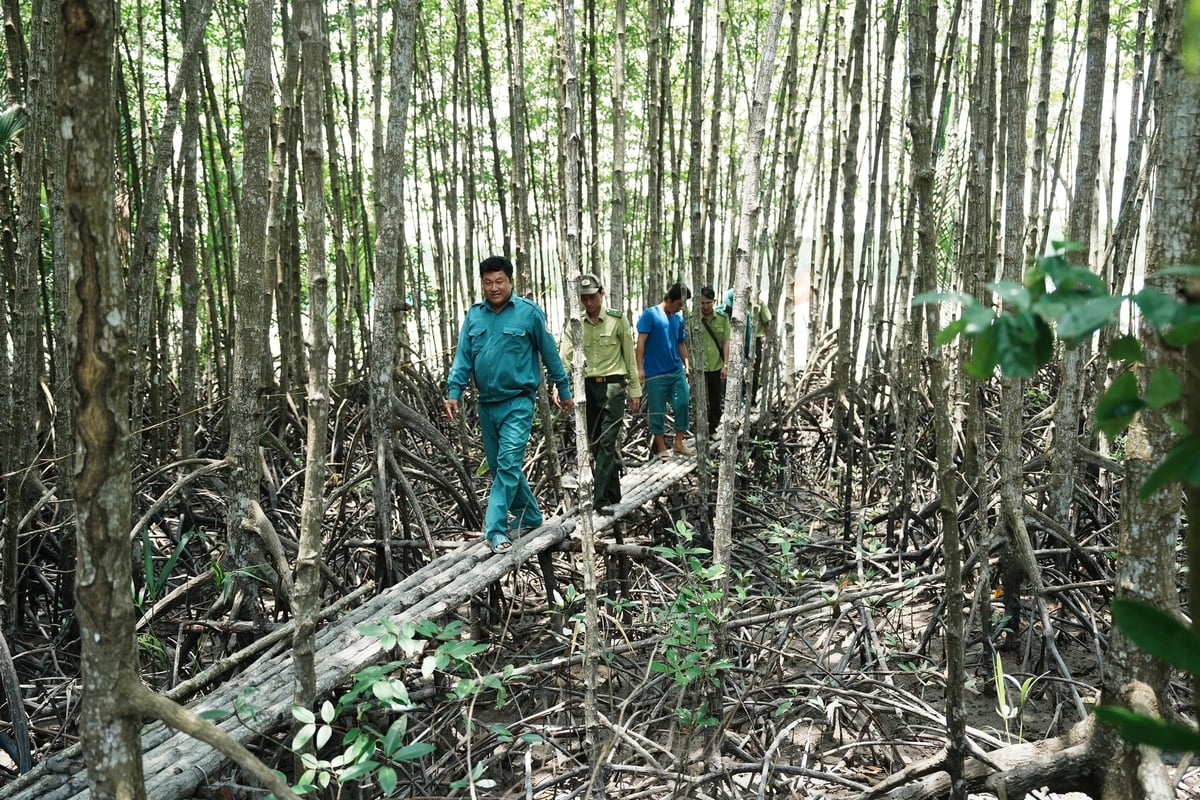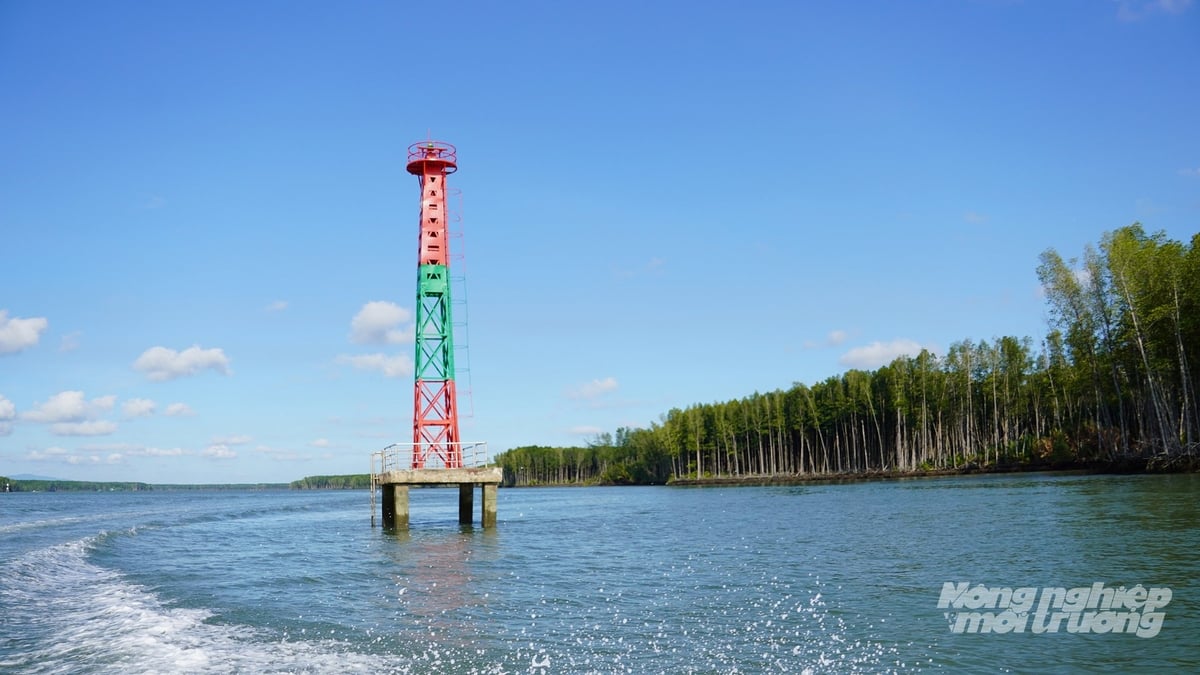November 5, 2025 | 14:46 GMT +7
November 5, 2025 | 14:46 GMT +7
Hotline: 0913.378.918
November 5, 2025 | 14:46 GMT +7
Hotline: 0913.378.918
Walking along the coastline of Can Gio District, one will encounter vast stretches of lush mangrove forests, standing tall like a massive natural fortress shielding the land from waves and wind, and embracing the coastal region against increasingly severe natural disasters. More than just the “green lung” of Ho Chi Minh City, the Can Gio mangrove forest is also a massive carbon reservoir, an ecological shield in the face of climate change, and a vital source of livelihood for thousands of local residents.

The dense root systems within the mangrove forest, especially those of pioneering plant species like Sonneratia and Avicennia, which grow in thick clusters, play a crucial role in preventing erosion and curbing coastal intrusion processes. Photo: Nguyen Thuy.
According to Mr. Huynh Duc Hoan, Director of the Ho Chi Minh City Protective and Special-Use Forest Management Board, the entire area currently comprises over 34,800 hectares of forest and forestry land. This includes nearly 19,000 hectares of planted forest, around 13,500 hectares of natural forest, and more than 2,300 hectares of other forestry land. The forest is divided into 24 subzones, with the An Hoa and An Phuoc areas playing a vital protective role for both Can Gio and the southeastern coastal region of Vietnam.
Mr. Huynh Duc Hoan emphasized that the top priority of the Management Board is to preserve the existing 34,800 hectares of forest and maintain a forest coverage rate of 48.8% by 2030. At the same time, the unit aims to improve forest quality to maximize its protective functions, preventing erosion and soil degradation, protecting the environment, and conserving the ecological landscape. The Board also focuses on reducing legal violations in the forestry sector, raising awareness about sustainable forest management, and gradually completing infrastructure to support forest protection efforts better.
"Forests not only offer ecological value but also provide stable environmental services that ensure financial resources for forestry workers and conservation activities," Mr. Huynh Duc Hoan noted, adding that the Board’s management strategy is centered on preserving the value of the Can Gio Mangrove Biosphere Reserve and enhancing its resilience against the impacts of climate change.
Speaking about the forest’s role in wave buffering, erosion prevention, and mitigating storm impacts, Mr. Huynh Duc Hoan explained that the dense root systems of the mangrove forest, especially from pioneering species like Sonneratia and Avicennia help accumulate alluvial deposits, reduce erosion, and block the force of sea waves. This contributes significantly to forming a protective mangrove belt along river mouths and coastal areas within the Can Gio protective forest system.

Forest rangers, local militia, and forest-protecting households regularly patrol key areas within the Can Gio protective forest. Photo: Phuc Lap.
Studies on the disaster-mitigation capabilities of mangrove forests have found that a 50-meter-wide mangrove belt can reduce the force of 1-meter-high waves to just 0.3 meters; with a width of 150 meters, large waves, including tsunamis, can be almost completely neutralized.
“With the current width and density of the Can Gio mangrove forest, it is capable of protecting northern Can Gio residential areas and even the inner city of Ho Chi Minh City from powerful waves,” affirmed Mr. Huynh Duc Hoan. He further noted that the most concrete evidence was seen during Typhoon Durian in 2006, which is one of the strongest storms ever to make landfall. While many other coastal areas, such as Tien Giang and Long An (in the past, before they had mangrove forests) suffered heavy damage, Can Gio recorded significantly lighter impacts.
Effectively protecting forested areas not only reduces riverbank erosion and landslides but also helps expand forest coverage. This facilitates natural succession processes that can give rise to new mangrove belts in the future. In turn, this contributes to adapting to the increasingly complex challenges of climate change, particularly the looming threat posed by rising sea levels.

The location of this lighthouse was once at the forest’s edge 20 years ago. However, due to the impacts of waves and climate change, the edge of the Can Gio mangrove forest has retreated by 20 meters and now stretches inland along dozens of kilometers. Photo: Nguyen Thuy.
The Can Gio forest not only plays a crucial role in disaster prevention but also significantly contributes to efforts to reduce greenhouse gas emissions, stabilize the climate, regulate temperatures, and maintain humidity in Ho Chi Minh City and its surrounding areas. For this reason, the Can Gio mangrove forest is often referred to as the “green lung” of the city and its neighboring regions.
According to estimates by Associate Professor Dr. Vien Ngoc Nam, the amount of carbon stored and absorbed above ground in the Can Gio forest ranges from 5 to 10 tons of CO2 per hectare per year. With over 32,000 hectares of forested area, this ecosystem can absorb more than 227,000 tons of CO2 annually, substantially contributing to Vietnam’s national effort to reduce greenhouse gas emissions.
Mr. Huynh Duc Hoan stated that the Management Board will continue to collaborate with relevant agencies to implement or propose in-depth studies aimed at guiding the sustainable development of the Can Gio mangrove ecosystem in response to climate change and rising sea levels. The goal is to build a multi-layered, multi-species forest structure that preserves biodiversity in line with the forest's natural succession.
In addition, the Board plans to propose detailed research on the value of ecosystem services provided by the Can Gio mangrove forest. These studies will support forest management and the sustainable development of natural resources, scientific research, environmental education, and communication. They will also assess the forest’s economic, social, and environmental effectiveness.
"The Can Gio protective forest is not just a green shield for coastal areas. It's also a lifeline for thousands of residents. Protecting the forest is not solely the responsibility of the management authority, but a shared duty of the entire community. When people are connected to the forest and take part in protecting it, we can ensure that this green lung is preserved for today and generations to come," emphasized Mr. Huynh Duc Hoan, Director of the Ho Chi Minh City Protective and Special-Use Forest Management Board.
Translated by Kieu Chi

(VAN) Low-emission production and the conditions for granting a ‘low-emission’ label for agricultural products were among the key topics addressed by the Ministry of Agriculture and Environment at the 2025 ‘Listening to Farmers’ Forum.

(VAN) The meeting took place as Viet Nam-Australia Comprehensive Strategic Partnership continues to thrive, with both sides strengthening cooperation in agriculture, trade, and technology.

(VAN) Quang Ngai is promoting the application of digital technology to expand markets for OCOP products and enhance product quality.

(VAN) The collaboration between Viet Nam and Ireland in food system transformation goes beyond capital or technology; it is a process of co-creating knowledge, starting at the policy level.

(VAN) Action plans are leaving the conference table and reaching the fields, where provinces like Dong Thap, Son La, and Nghe An are piloting models that integrate production with livelihoods and the environment.

(VAN) A new, collaborative management approach is being piloted, replacing separate silos with coordinated action across multiple sectors to build a transparent, sustainable, and accountable system.

(VAN) The Food System Transformation (FST) is expanding into the livestock sector, where biotechnology is emerging as a new direction to reduce antibiotics, enhance quality, and improve food safety.